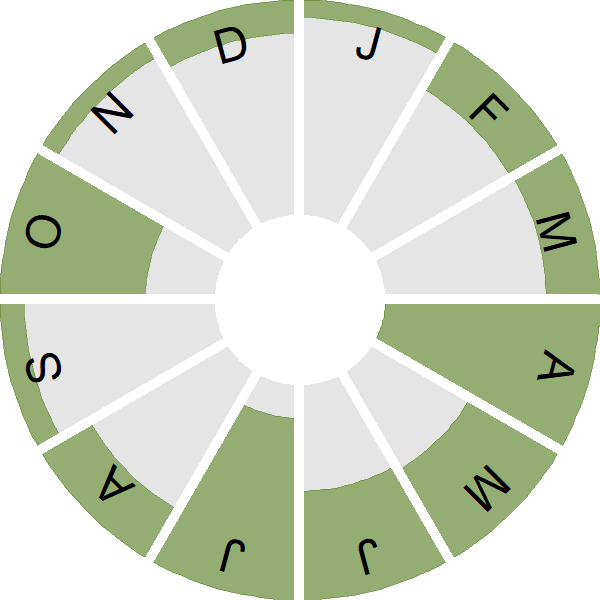Scottish Crossbill
Introduction
A close relative of the Common Crossbill, Scottish Crossbill is only separated by its large bill and deeper call.
The Scottish Crossbill is a controversial bird. Some authorities claim that it is just a slightly larger Common Crossbill, whilst others think it might actually be Parrot Crossbill, a different species altogether. Its breeding range is restricted to north-east Scotland, and while it be may found a little further west in winter, this crossbill still lives up to its name.
Crossbills are amongst our earliest breeding birds and it is not unusual for the yellow-green female to be sitting on eggs in late February, and being fed by the ever-attentive deep red male. Like all crossbills, Scottish Crossbills can be either right or left 'handed', their bill tips crossing either way.
Key Stats
Identification
Songs and Calls
Song:
Call:
Begging call:
Status and Trends
Conservation Status
Population Change
The Scottish Crossbill can only be separated reliably from Common Crossbill by differences in bill measurements and by some diagnostic calls (Summers & Piertney 2003). As the diagnostic calls have only been described recently, there is no reliable information about the historical status of the species. A special survey in 2008 recorded Crossbill calls from 387 survey points to enable accurate species identification and produced an estimate of 6,800 pairs of Scottish Crossbill , higher than previously thought (Summers & Buckland 2011).
Distribution
Scottish Crossbills can be reliably separated from Common Crossbills only on subtle differences in bill measurements or by its distinctive excitement call. Previous information on Scottish Crossbill distribution and population size might suffer from unreliable field identifications and we do not currently have an accurate map of Scottish Crossbill distribution. Information from dedicated field surveys in 2008 suggest most Scottish Crossbills occur in northeast Scotland, in Nairn, Moray and Banff, extending southward into lower Deeside and the other main concentration extended from Sutherland to Easter Ross and eastern Inverness-shire.
European Distribution Map
Distribution Change
Changing understanding of identification criteria for Scottish Crossbill make assessing range changes impossible.
Seasonality
Scottish Crossbill is a very localised resident and can be encountered throughout the year.
Movement
Britain & Ireland movement
Foreign locations of birds ringed or recovered in Britain & Ireland
Dots show the foreign destinations of birds ringed in Britain & Ireland, and the origins of birds ringed overseas that were subsequently recaptured, resighted or found dead in Britain & Ireland. Dot colours indicate the time of year that the species was present at the location.
- Winter (Nov-Feb)
- Spring (Mar-Apr)
- Summer (May-Jul)
- Autumn (Aug-Oct)

Biology
Productivity and Nesting
Nesting timing
Egg measurements
Clutch Size
Survival and Longevity
Survival is shown as the proportion of birds surviving from one year to the next and is derived from bird ringing data. It can also be used to estimate how long birds typically live.
View number ringed each year in the Online Ringing Report.
lifespan
Classification, names and codes
Classification and Codes
- Order: Passeriformes
- Family: Fringillidae
- Scientific name: Loxia scotica
- Authority: Hartert, 1904
- BTO 2-letter code: CY
- BTO 5-letter code: SCOCR
- Euring code number: 16670
Alternate species names
- Catalan: trencapinyes escocès
- Czech: krivka skotská
- Danish: Skotsk Korsnæb
- Dutch: Schotse Kruisbek
- Estonian: šoti käbilind
- Finnish: skotlanninkäpylintu
- French: Bec-croisé d’Écosse
- Gaelic: Cam-ghob
- German: Schottlandkreuzschnabel
- Hungarian: skót keresztcsoru
- Icelandic: Skotanefur
- Italian: Crociere di Scozia
- Latvian: Skotijas krustknabis
- Lithuanian: škotinis kryžiasnapis
- Norwegian: Skottekorsnebb
- Polish: krzyzodziób szkocki
- Portuguese: cruza-bico-escocês
- Slovak: krivonos škótsky
- Slovenian: škotski krivokljun
- Spanish: Piquituerto escocés
- Swedish: skotsk korsnäbb
Research
Causes of Change and Solutions
Causes of change
The trend for Scottish Crossbill is uncertain as we have no knowledge of the population prior to 2008, and hence the causes of any changes which may have occurred are also unknown. However, it is likely that the species is affected by similar factors to the Common Crossbill. These factors include changes in the availability of cone crops which are known to prompt long-distance movements across the continent in the Common Crossbill, although ring recoveries and re-sightings of colour-ringed birds suggest only relatively short distance movements for the Scottish Crossbill (Marquiss & Rae 2002).

